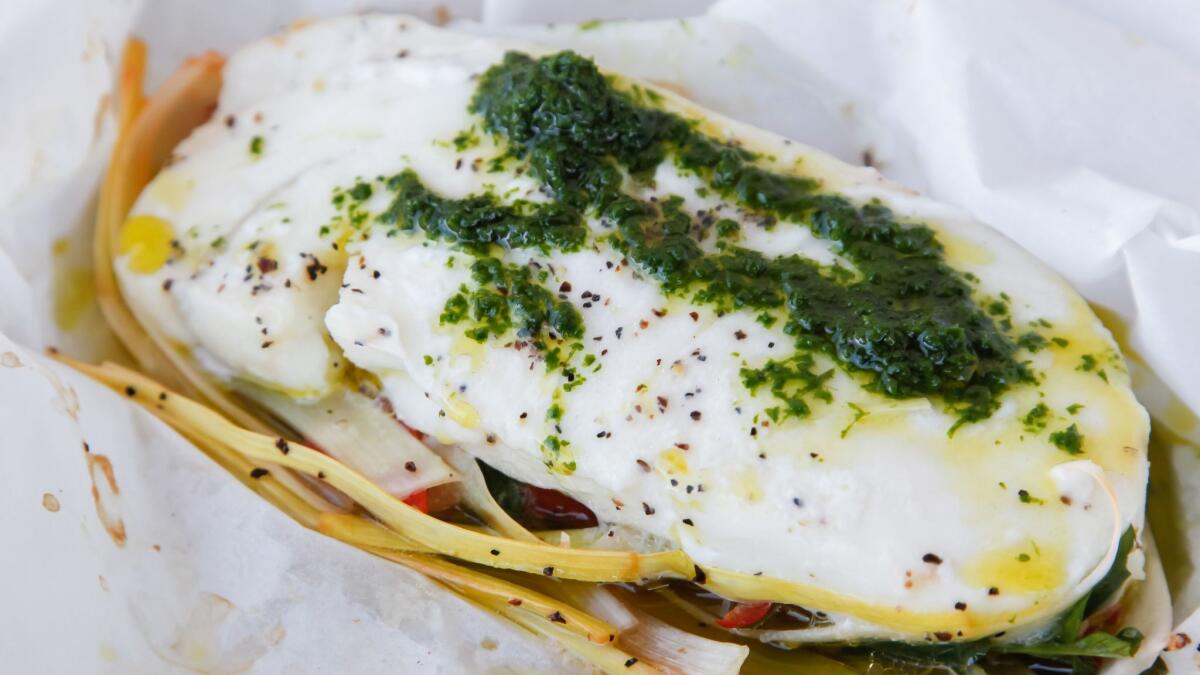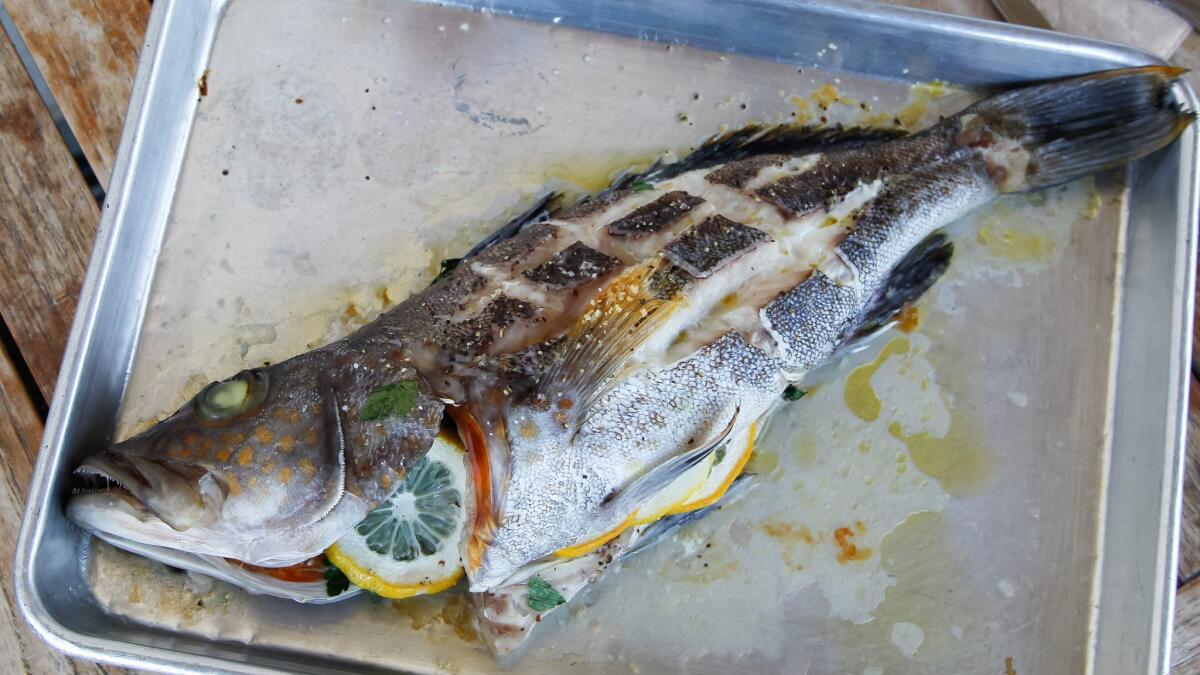Finessing white fish
Like so many, I’ve worked to incorporate more fish into my family’s diet, especially healthful white fish. That’s easy to do when eating out and someone else is cooking. Yet, many home cooks — myself included — are sometimes frustrated with the results when cooking fish at home.
Often I’ll buy a beautiful piece of lean white fish — a category including many species, all low calorie — only to create an unappetizing mess when I sauté it, leaving both top and bottom of the fish adhering to my nonstick griddle.
What, oh what, am I doing wrong?
To find out how best to cook white fish at home, I went to see avid fisherman and fish cooking guru Mitch Conniff, chef/owner of Mitch’s Seafood, located on the Embarcadero in Point Loma, alongside the fishing docks. His laidback eatery goes through more than 1,000 pounds of white fish every week, most sourced from Catalina Offshore Products and local fishermen.
It turns out I’ve been cooking these delicate fish all wrong.

“A lot of people try to put the fish on a grill or griddle and get only about half off,” Conniff explained. Or, they’ll put the fish on a piece of foil and then find it sticks to the foil, he said.
Conniff told me the higher temperature, direct-heat method I had been using, whether on a cooktop or a grill, is suited only for higher fat fish, such as darker meaty fish or fattier white fish such as Baja grouper, tilefish, black cod or Alaskan halibut. Leaner white fish, such as California halibut, snapper and the many varieties of rockfish or seabass, cook better with lower heat methods, he said. Higher heat dries out the leaner varieties, while lower heat may render fattier varieties a bit soggy.
Conniff’s favorite methods for cooking white fish at home are steaming in parchment paper packets atop a bed of aromatic vegetables or roasting them whole in the oven. Both are fast and easy.
“Generally, the simpler the method, the better,” Conniff said.
He advocates cooking whole fish rather than fillets because the cooking process is “more forgiving,” as with a whole chicken. To prevent whole fish from curling up, cut quarter- to half-inch-deep slits through both sides of the fish skin before cooking. For best results, defrost your frozen fish before cooking.
With abundant species of white fish available, one of its best features is its interchangeability. While different types vary subtly in flavor, texture and firmness, don’t hesitate to substitute one variety for another, opting for freshness, availability and quality.
“You can use almost any type of white fish for any recipe,” Conniff explained.
It’s easy to overcook white fish, he warned. If you cook fish “until it flakes,” as many older cookbooks directed, it’s overdone. And the old rule of “10 minutes per inch of thickness” is often too long, except when roasting.
A fish’s fat content is a more reliable determinant of appropriate cooking time. A leaner fish — such as those caught in warmer waters off the California or Baja coast — might cook in only four to six minutes per inch of thickness, while a similar thickness of Baja grouper might require seven to nine minutes per inch. Fish caught in colder waters, such as Alaskan halibut, is richer in fat than its California cousin.
To determine a fish’s fattiness, look for a thin layer of pinkish or opaque white fat under the skin, or ask your fishmonger.
But if you’re not sure about the fish’s fat content, how can you tell if it’s done?
The best way, Conniff explained, is to check its firmness, just as with steaks or chops, and look at its color. The firmer the fish, the more cooked it is.
“If it falls apart easily, it’s done, headed to overdone. If it’s very opaque in the middle it’s not done. Pull it off before you think it’s ready because it will continue to cook with carry-over heat,” he said.
And, he pointed out, if the fish is insufficiently cooked, just return it to the heat to continue cooking.
Conniff’s preference for simplicity extends to seasonings. At his restaurant he seasons fish only with salt and Spanish paprika, rather than pungent freshly ground black pepper. Too-strong seasonings, he explained, tend to overpower the flavor. He doesn’t coat fish with flour or breadcrumbs prior to sautéing, since they also mask its flavor, though a thin flour coating can protect and seal a delicate fish.
“I like to be able to taste the fish’s flavor,” he said.

Conniff, who grew up around San Jose in a family that fished whenever and wherever possible, began working in restaurants at 17, starting as a dishwasher. He developed his culinary passion while working through college at a seafood restaurant near San Jose.
Ready for adventure, he next combined his love of fishing and cooking, spending seven years as chef aboard a 90-foot sportfisher, feeding guests during extended fishing trips from San Diego along the Mexican coast.
After a stint at Hotel Solamar’s JSix Restaurant, rising to banquet chef, he went out on his own, taking over Hudson Bay Seafood in November 2008, and renaming it Mitch’s Seafood a year later.
“There didn’t seem to be many places in San Diego where you could get fresh, sustainable seafood at an affordable price. There’s no reason people out for the day shouldn’t be able to go out in flip-flops and eat good seafood at a reasonable price,” he explained.
Based on the regular crowds, there’s no doubt Mitch’s Seafood fills that niche.
Larson is a San Diego freelance writer.
The interchangeability of white fish
“White fish” describes a category of white-fleshed fish that varies slightly in flavor and character but is lean and low in calories. Among those considered white fish are halibut, seabass, rockfish, snapper, grouper, cod, sole, flounder and numerous others.
With many fish cookbooks written from an East Coast perspective, focusing on varieties not common on the West Coast — such as sole, monkfish, Atlantic cod or flounder — it’s important to note that white fish recipes are almost always interchangeable. Just substitute whatever type of fish is freshest and most available at the market.
When in doubt, your best bet is to develop a relationship with your fishmonger or the staff of your supermarket fish counter who can steer you to the best choice for your meal. Explain what type of fish you’re looking for, whether a white or meatier fish, fillets or whole, and ask what’s fresh, readily available and best quality — which doesn’t necessarily mean most expensive.
“The meal will always be better with better quality fish,” Mitch Conniff explained.
Nicole Sours Larson

Whole Roasted Fish
This works well on the grill if using indirect heat. Slitting both sides of the fish prevents the skin from curling as it cooks and helps the fish cook evenly. Plan for about three-quarters to 1 pound of whole fish per person.
Makes 2-3 servings
A 2-to-3-pound white fish (seabass, rockfish, snapper, grouper or whatever is available), cleaned and scaled with the gills removed
5 thin slices lemon
Small bundle of herbs to taste, with Italian parsley, chives, tarragon or dill recommended
2-3 tablespoons olive oil for basting
Salt and pepper to taste
Preheat oven to 450 degrees or heat a grill to about 450 degrees, setting up a grill area with indirect heat.
On each side of the fish cut 3 or 4 diagonal slits into the skin of the fillet about ¼- to ½-inch deep into the flesh. Brush both sides of the fish with olive oil. Season the both exterior and interior cavity with salt and pepper.
Place the fish on an oiled sheet pan. Stuff the lemon slices and herb bundle into the cavity of the fish.
Roast the fish in the oven or place the sheet pan on the grill over indirect heat, covering the grill. Roast about 12 to 15 minutes, depending on the size. The fish is done when the flesh is opaque throughout. Alternatively, a thermometer inserted into the flesh of the fish should read about 125 degrees.
Serve with Herb Salsa Verde (recipe follows) garnished with lemon slices.
Herb Salsa Verde
This is an excellent accompaniment for any grilled or roasted meat or vegetable and especially chicken and fish. The sauce will last several days in the refrigerator, but make sure to bring it to room temperature before use.
Makes about 2 cups
2 cups Italian parsley leaves, loosely packed
1 cup basil leaves, loosely packed
1 tablespoon chives, thinly sliced
½ cup cilantro leaves, loosely packed
1 teaspoon orange zest
1 teaspoon lemon zest
1-2 garlic cloves, finely minced
1 anchovy fillet, finely minced or small squeeze of anchovy paste (optional, but it really adds that little something to the sauce)
1 cup good quality extra virgin olive oil
Salt to taste
Finely chop all of the herbs with an extremely sharp knife to avoid bruising the herbs and ensure they maintain their bright green color; or chop all herbs together in a food processor.
Place in bowl and stir in remaining ingredients except salt; the anchovy is quite salty, so taste before adding salt.
Let sit at room temperature for about a half hour to let the flavors marry before using.
Fish in Parchment Paper
You can also cook parchment paper packets on the grill, using indirect heat and placing the packets on a metal tray or wrapping them in foil to protect them from the flames.
Makes 4 individual parchment packets servings
½ cup carrots, julienned (sliced in matchstick strips)
½ cup leeks, julienned
½ cup red bell pepper, julienned
½ cup Italian parsley, leaves only
2 garlic cloves, sliced very thinly
Four 12-inch-square sheets parchment paper
Four 6-ounce portions of any white-fleshed fish (halibut, rockfish, grouper or whatever is fresh and in season)
4 small pats butter
4-8 tablespoons dry white wine
Salt and pepper to taste
Preheat oven to 425 degrees.
Mix together all sliced vegetables and garlic. Lay sheets of parchment paper on the counter. Place equal amounts vegetable mixture in the center of each piece of parchment and season lightly with salt and pepper. Place a piece of fish atop each mound of vegetables. Season fish with salt and pepper, placing a pat of butter on each. Sprinkle 1 to 2 tablespoons wine on each fish slice, being careful to limit the amount of liquid in each packet.
To close, bring two opposite sides of the parchment together and fold edges over 3-4 times, making sure to leave room in the packet for steam to build up. Fold the edges of remaining sides 3-4 times, folding them under to allow the weight of the packet to rest on the folds, keeping them sealed.
Place each packet on a sheet tray, allowing some space between packets. Place the sheet tray in the oven. Cook for about 10-15 minutes, depending on the thickness of the fish, about 10 minutes per inch of thickness.
Serve right from the parchment packet or unwrap the parchment and remove by sliding a spatula underneath the vegetables, removing everything at once and pouring the juices over the fish as a sauce. Serve with rice or potatoes.
All recipes from Mitch Conniff, owner/chef of Mitch’s Seafood in Point Loma
More to Read
Sign up for our L.A. Times Plants newsletter
At the start of each month, get a roundup of upcoming plant-related activities and events in Southern California, along with links to tips and articles you may have missed.
You may occasionally receive promotional content from the Los Angeles Times.






